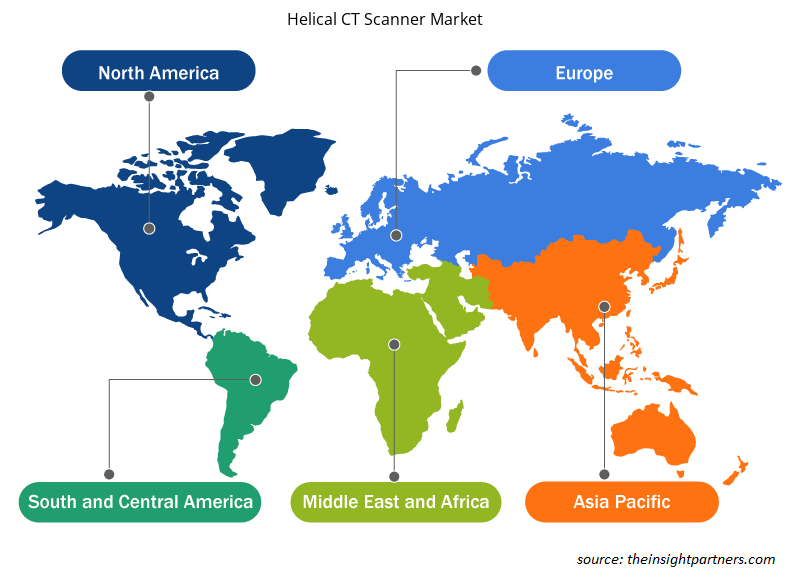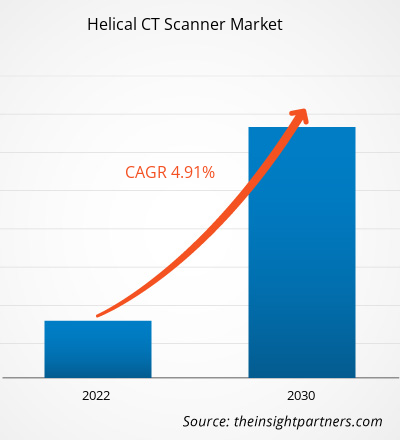[調査レポート] ヘリカルCTスキャナの市場価値は、2022年の8億4,235万米ドルから2030年には12億3,629万米ドルに成長すると予測されており、市場は2022年から2030年にかけて4.91%のCAGRを記録すると予想されています。
市場洞察とアナリストの見解:
このレポートで提示されるヘリカル CT スキャナー市場の予測は、この市場の関係者が成長戦略を計画するのに役立ちます。
ヘリカル CT スキャナー (スパイラル CT スキャナー) は、ヘリカル スキャン法を使用して人体の詳細な断面画像を作成する高度な医療用画像装置です。慢性疾患や心血管疾患の罹患率が上昇するにつれて、ヘリカル CT スキャナーなどの正確で効率的な診断ツールの必要性も高まっています。従来の CT スキャナーとは異なり、ヘリカル スキャナーは患者の周囲で X 線源と検出器を連続的に回転させる機能を備えています。
高度な画像処理機能への注目の高まりと、診断画像処理におけるより高速なスキャン時間でより高い空間解像度を求める声が、ヘリカルCTスキャナ市場の成長を牽引する主な要因となっています。さらに、これらのスキャナによる継続的なデータ取得により、高解像度の3次元画像が生成され、内部構造の視覚化が向上します。検出器技術、線量低減技術、画像再構成アルゴリズムの継続的な技術進歩により、ヘリカルCTスキャナの性能と安全性は向上し続けています。ヘリカルCTスキャナ市場のトレンドには、ヘリカルCTスキャナへの人工知能と機械学習の統合が含まれています。
成長の原動力と課題:
慢性疾患の罹患率増加がヘリカルCTスキャナ市場を活性化
心血管疾患、がん、神経疾患の発生率の上昇により、内部の解剖学的構造を詳細かつ正確に視覚化できる高度な診断用画像ツールの必要性が高まっています。国立健康統計センターによると、2021年に米国で報告された新規がん症例は約190万件です。コンピューター断層撮影は、がんの診断に使用される信頼性の高い画像技術の1つです。2021年9月にハーバードヘルスが発表した記事によると、米国では年間約9,000万件のCTスキャン手順が行われています。さらに、国立がん研究所(NCI)は、NCIが資金提供した全国肺スクリーニング試験(NLST)で、喫煙歴のある55〜74歳の個人が低線量ヘリカルCTでスクリーニングされた場合、標準的な胸部X線でスクリーニングされた個人よりも肺がんで死亡するリスクが20%低いことが明らかになったと報告しています。タバコ製品を使用したことがない人は、肺がんを発症する可能性が低すぎるため、肺がん検診の恩恵を受けられないと考えられています。
ヘリカルCTスキャナは、動的な断面像を提供する包括的な3D画像を撮影する能力を備えており、これらの疾患の診断、ステージング、モニタリングにおいて極めて重要な役割を果たしています。その汎用性とさまざまな臨床専門分野にわたる幅広い用途により、腫瘍の検出、血管状態の評価、および全体的な診断画像に不可欠なものとなっています。がんやその他の慢性疾患の負担が増加するにつれて、ヘリカルCTスキャナが提供する正確で効率的な診断ソリューションの需要はますます顕著になっています。したがって、慢性疾患や複雑な病状の蔓延の増加により、ヘリカルCTスキャナの市場規模が拡大しています。
これらの高度な画像診断システムを購入して導入するには、多額の初期投資が必要です。そのため、多くの医療施設、特にコストに敏感な国や資金が限られている施設では、この機器の導入に消極的です。高額な設備投資には、スキャナの調達、およびサイトの計画、インフラストラクチャの変更、設置、スタッフのトレーニングに関連するコストが含まれます。さらに、メンテナンス、アップグレード、および人員トレーニングの費用が総所有コストに影響します。このような金銭的負担は、特に小規模なクリニックや施設の医療提供者にとって、ヘリカル CT スキャナの導入において課題となることが多く、スキャナの広範な可用性とアクセス性が制限されています。コスト障壁に対処するための取り組みには、資金調達オプション、費用対効果の高い購入モデル、および協力的なパートナーシップの検討が含まれ、これらの重要な診断ツールをより幅広い医療環境でより入手しやすくすることが含まれます。しかし、これらのスキャン システムに関連する高い設置コストは、ヘリカル CT スキャナ市場の成長を妨げています。
要件に合わせてレポートをカスタマイズする
このレポートの一部、国レベルの分析、Excelデータパックなど、あらゆるレポートを無料でカスタマイズできます。また、スタートアップや大学向けのお得なオファーや割引もご利用いただけます。
- このレポートの主要な市場動向を入手してください。この無料サンプルには、市場動向から見積もりや予測に至るまでのデータ分析が含まれます。
レポートのセグメンテーションと範囲:
ヘリカル CT スキャナ市場分析は、以下のセグメントを考慮して実施されました。タイプ、スライスタイプ、エンドユーザーに基づいて分類されています。タイプ別では、市場は二層と多層に分かれています。スライスタイプに基づいて、市場は1〜16スライス、17〜64スライス、128〜160スライス、および> 160スライスに分かれています。エンドユーザー別では、市場は病院、医療センター、および外来手術センターに分割されています。地理に基づいて、ヘリカルCTスキャナー市場は、北米(米国、カナダ、メキシコ)、ヨーロッパ(英国、ドイツ、フランス、イタリア、スペイン、その他のヨーロッパ)、アジア太平洋(中国、日本、インド、オーストラリア、韓国、その他のアジア太平洋)、中東およびアフリカ(UAE、サウジアラビア、南アフリカ、その他の中東およびアフリカ)、南米および中米(ブラジル、アルゼンチン、その他の南米および中米)に分割されています。
セグメント分析:
タイプベースの洞察
タイプに基づいて、ヘリカルCTスキャナ市場は、二層および多層の固定式およびポータブルCTスキャナに分類されます。多層セグメントは、2022年にヘリカルCTスキャナ市場でより大きなシェアを占めました。2022年から2030年の間に、より高いCAGRを記録すると予想されます。
スライスタイプベースのインサイト
ヘリカル CT スキャナ市場は、スライスの種類に基づいて、1~16 スライス、17~64 スライス、128~160 スライス、および 160 スライス超に分かれています。17~63 スライスのセグメントは、2030 年までに大きなシェアを占めると予想されています。
エンドユーザーベースの洞察
エンドユーザーの観点から見ると、ヘリカルCTスキャナ市場は、病院、医療センター、外来手術センターに分類されます。エンドユーザーの観点から見ると、病院セグメントは2022年に最大のヘリカルCTスキャナ市場シェアを占めました。2022年から2030年の間に最高のCAGRを記録すると予想されています。
ヘリカルCTスキャナ市場の地域別分析
予測期間を通じてヘリカル CT スキャナ市場に影響を与える地域的な傾向と要因は、Insight Partners のアナリストによって徹底的に説明されています。このセクションでは、北米、ヨーロッパ、アジア太平洋、中東、アフリカ、南米、中米にわたるヘリカル CT スキャナ市場のセグメントと地理についても説明します。

- ヘリカルCTスキャナ市場の地域別データを入手
ヘリカルCTスキャナ市場レポートの範囲
| レポート属性 | 詳細 |
|---|---|
| 2022年の市場規模 | 8億4,235万米ドル |
| 2030年までの市場規模 | 12億3,629万米ドル |
| 世界のCAGR(2022年 - 2030年) | 4.91% |
| 履歴データ | 2020-2022 |
| 予測期間 | 2022-2030 |
| 対象セグメント | タイプ別
|
| 対象地域と国 | 北米
|
| 市場リーダーと主要企業プロフィール |
|
市場プレーヤーの密度:ビジネスダイナミクスへの影響を理解する
ヘリカル CT スキャナ市場は、消費者の嗜好の変化、技術の進歩、製品の利点に対する認識の高まりなどの要因により、エンドユーザーの需要が高まり、急速に成長しています。需要が高まるにつれて、企業は提供を拡大し、消費者のニーズを満たすために革新し、新たなトレンドを活用し、市場の成長をさらに促進しています。
市場プレーヤー密度とは、特定の市場または業界内で活動している企業または会社の分布を指します。これは、特定の市場スペースに、その規模または総市場価値と比較して、どれだけの競合相手 (市場プレーヤー) が存在するかを示します。
ヘリカルCTスキャナ市場で事業を展開している主要企業は次のとおりです。
- キヤノンメディカルシステムズ株式会社
- トリニティエクシムリミテッド
- 富士フイルムホールディングス
- GEヘルスケア
- カールツァイスAG
免責事項:上記の企業は、特定の順序でランク付けされていません。

- ヘリカルCTスキャナ市場のトップキープレーヤーの概要を入手
地域分析:
地理的に見ると、ヘリカルCTスキャナ市場レポートの範囲は、北米、ヨーロッパ、アジア太平洋、中東およびアフリカ、南米および中米を網羅しています。北米は2022年にヘリカルCTスキャナ市場で最大のシェアを占め、予測期間中もその優位性(シェアに関して)を維持すると予測されています。北米の市場は、米国、カナダ、メキシコに分割されています。米国は、北米および世界の市場で最大のシェアを占めています。この国の市場成長は、炎症性疾患の有病率の増加、主要な市場プレーヤーの存在、ヘルスケア分野の継続的な進歩、革新的なヘリカルCTスキャンシステムへのアクセス、およびCTスキャン技術の発展に起因しています。
競争環境と主要企業:
キヤノンメディカルシステムズ株式会社、トリニティエクシム株式会社、富士フイルムホールディングス株式会社、GEヘルスケア株式会社、カールツァイス株式会社、フィリップス株式会社、深圳安科株式会社、島津製作所株式会社、シーメンス株式会社、およびSternMed GmbHは、ヘリカルCTスキャナ市場レポートで紹介されている主要企業の一部です。これらの企業は、世界中で高まる消費者の需要を満たすために、提供品目の拡大に注力しています。グローバルな展開により、多くの顧客にサービスを提供でき、その結果、市場での存在感を拡大することができます。
- 過去2年間の分析、基準年、CAGRによる予測(7年間)
- PEST分析とSWOT分析
- 市場規模価値/数量 - 世界、地域、国
- 業界と競争環境
- Excel データセット


- Underwater Connector Market
- Electronic Shelf Label Market
- Grant Management Software Market
- Integrated Platform Management System Market
- Foot Orthotic Insoles Market
- Water Pipeline Leak Detection System Market
- Dairy Flavors Market
- Sandwich Panel Market
- Adaptive Traffic Control System Market
- Blood Collection Devices Market

Report Coverage
Revenue forecast, Company Analysis, Industry landscape, Growth factors, and Trends

Segment Covered
This text is related
to segments covered.

Regional Scope
North America, Europe, Asia Pacific, Middle East & Africa, South & Central America

Country Scope
This text is related
to country scope.
よくある質問
Increasing focus on advanced imaging capabilities and the demand for higher spatial resolution are the key factors driving the the helical CT scanner market growth. Furthermore, helical CT scanner market trends include increasing adoption of AI (Artificial Intelligence) and ML (Machine Learning) in helical CT scanners.
The helical CT scanner market is segmented based on type into double-layer and multi-layer stationary and portable CT scanners. The multi-layer segment held a larger market share in 2022 and is anticipated to register the highest CAGR during 2022–2030.
The helical CT scanner market, based on slice type, is bifurcated into 1-16 Slices 17-64 Slices,128-160 Slices, and >160 Slices. 17-63 Slices segment is anticipated to hold a significant helical CT scanner market share by 2030.
Helical CT scanners, or spiral CT scanners, are advanced medical imaging devices that utilize a helical scanning method to produce detailed cross-sectional images of the body. Unlike traditional CT scanners, helical scanners feature a continuous rotation of the X-ray source and detectors around the patient. In contrast, the patient table moves through the scanner in a helical or spiral path. This continuous data acquisition allows for the creation of high-resolution three-dimensional images, enabling enhanced visualization of internal structures.
The helical CT scanner market was valued at US$ 842.35 million in 2022.
The helical CT scanner market has major market players, including Canon Medical Systems Corporation, Trinity Exim Limited, Fujifilm Holdings, GE Healthcare, Carl Zeiss AG, Philips, Shenzhen Anke, Shimadzu Corporation, Siemens AG, and SternMed GmbH.
The helical CT scanner market is expected to be valued at US$ 1,236.29 million in 2030.
Trends and growth analysis reports related to Life Sciences : READ MORE..
The List of Companies - Helical CT Scanner Market
- Canon Medical Systems Corporation
- Trinity Exim Limited
- Fujifilm Holdings
- GE Healthcare
- Carl Zeiss AG
- Philips
- Shenzhen Anke
- Shimadzu Corporation
- Siemens AG
- SternMed GmbH
The Insight Partners performs research in 4 major stages: Data Collection & Secondary Research, Primary Research, Data Analysis and Data Triangulation & Final Review.
- Data Collection and Secondary Research:
As a market research and consulting firm operating from a decade, we have published and advised several client across the globe. First step for any study will start with an assessment of currently available data and insights from existing reports. Further, historical and current market information is collected from Investor Presentations, Annual Reports, SEC Filings, etc., and other information related to company’s performance and market positioning are gathered from Paid Databases (Factiva, Hoovers, and Reuters) and various other publications available in public domain.
Several associations trade associates, technical forums, institutes, societies and organization are accessed to gain technical as well as market related insights through their publications such as research papers, blogs and press releases related to the studies are referred to get cues about the market. Further, white papers, journals, magazines, and other news articles published in last 3 years are scrutinized and analyzed to understand the current market trends.
- Primary Research:
The primarily interview analysis comprise of data obtained from industry participants interview and answers to survey questions gathered by in-house primary team.
For primary research, interviews are conducted with industry experts/CEOs/Marketing Managers/VPs/Subject Matter Experts from both demand and supply side to get a 360-degree view of the market. The primary team conducts several interviews based on the complexity of the markets to understand the various market trends and dynamics which makes research more credible and precise.
A typical research interview fulfils the following functions:
- Provides first-hand information on the market size, market trends, growth trends, competitive landscape, and outlook
- Validates and strengthens in-house secondary research findings
- Develops the analysis team’s expertise and market understanding
Primary research involves email interactions and telephone interviews for each market, category, segment, and sub-segment across geographies. The participants who typically take part in such a process include, but are not limited to:
- Industry participants: VPs, business development managers, market intelligence managers and national sales managers
- Outside experts: Valuation experts, research analysts and key opinion leaders specializing in the electronics and semiconductor industry.
Below is the breakup of our primary respondents by company, designation, and region:

Once we receive the confirmation from primary research sources or primary respondents, we finalize the base year market estimation and forecast the data as per the macroeconomic and microeconomic factors assessed during data collection.
- Data Analysis:
Once data is validated through both secondary as well as primary respondents, we finalize the market estimations by hypothesis formulation and factor analysis at regional and country level.
- Macro-Economic Factor Analysis:
We analyse macroeconomic indicators such the gross domestic product (GDP), increase in the demand for goods and services across industries, technological advancement, regional economic growth, governmental policies, the influence of COVID-19, PEST analysis, and other aspects. This analysis aids in setting benchmarks for various nations/regions and approximating market splits. Additionally, the general trend of the aforementioned components aid in determining the market's development possibilities.
- Country Level Data:
Various factors that are especially aligned to the country are taken into account to determine the market size for a certain area and country, including the presence of vendors, such as headquarters and offices, the country's GDP, demand patterns, and industry growth. To comprehend the market dynamics for the nation, a number of growth variables, inhibitors, application areas, and current market trends are researched. The aforementioned elements aid in determining the country's overall market's growth potential.
- Company Profile:
The “Table of Contents” is formulated by listing and analyzing more than 25 - 30 companies operating in the market ecosystem across geographies. However, we profile only 10 companies as a standard practice in our syndicate reports. These 10 companies comprise leading, emerging, and regional players. Nonetheless, our analysis is not restricted to the 10 listed companies, we also analyze other companies present in the market to develop a holistic view and understand the prevailing trends. The “Company Profiles” section in the report covers key facts, business description, products & services, financial information, SWOT analysis, and key developments. The financial information presented is extracted from the annual reports and official documents of the publicly listed companies. Upon collecting the information for the sections of respective companies, we verify them via various primary sources and then compile the data in respective company profiles. The company level information helps us in deriving the base number as well as in forecasting the market size.
- Developing Base Number:
Aggregation of sales statistics (2020-2022) and macro-economic factor, and other secondary and primary research insights are utilized to arrive at base number and related market shares for 2022. The data gaps are identified in this step and relevant market data is analyzed, collected from paid primary interviews or databases. On finalizing the base year market size, forecasts are developed on the basis of macro-economic, industry and market growth factors and company level analysis.
- Data Triangulation and Final Review:
The market findings and base year market size calculations are validated from supply as well as demand side. Demand side validations are based on macro-economic factor analysis and benchmarks for respective regions and countries. In case of supply side validations, revenues of major companies are estimated (in case not available) based on industry benchmark, approximate number of employees, product portfolio, and primary interviews revenues are gathered. Further revenue from target product/service segment is assessed to avoid overshooting of market statistics. In case of heavy deviations between supply and demand side values, all thes steps are repeated to achieve synchronization.
We follow an iterative model, wherein we share our research findings with Subject Matter Experts (SME’s) and Key Opinion Leaders (KOLs) until consensus view of the market is not formulated – this model negates any drastic deviation in the opinions of experts. Only validated and universally acceptable research findings are quoted in our reports.
We have important check points that we use to validate our research findings – which we call – data triangulation, where we validate the information, we generate from secondary sources with primary interviews and then we re-validate with our internal data bases and Subject matter experts. This comprehensive model enables us to deliver high quality, reliable data in shortest possible time.


 このレポートの無料サンプルを入手する
このレポートの無料サンプルを入手する